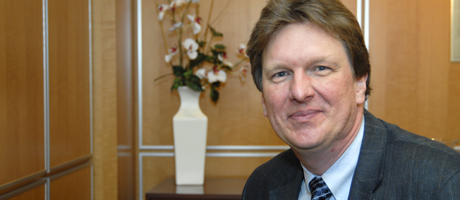By Jennifer Eder
Michael Plesniak, chair of GW’s Department of Mechanical and Aerospace Engineering, has been named a fellow of the American Association for the Advancement of Science (AAAS) for his significant research and leadership in fluid dynamics.
Since joining the School of Engineering and Applied Science in 2008, Dr. Plesniak has focused his research on biomedical flows, including speech production and cardiovascular flows.
“Life depends on fluid flow and heat transport. Blood flow and the respiratory system are essentially what make life possible,” says Dr. Plesniak. “There are so many different areas and opportunities for me to apply my expertise in fluid dynamics to medical applications.”
AAAS is the world’s largest scientific society, which publishes Science, a weekly peer-reviewed journal. Beginning in 1874, fellows are elected each year for their advancement of science and receive a certificate and a rosette pin. This year, 503 AAAS members were named fellows.
“All of us at SEAS are very proud of Professor Plesniak being named a fellow of the American Association for the Advancement of Science,” says SEAS Dean David Dolling. “This is a significant career achievement for him, and it reflects the respect his peers have for him and his work. It also reflects well on SEAS and shows the caliber of our faculty and their research contributions.”
Before coming to GW, Dr. Plesniak was a professor of mechanical engineering at Purdue University for 17 years. He has also held positions as the Eugene Kleiner Professor for Innovation in Mechanical Engineering at the Polytechnic University of New York and as director of the Fluid Dynamics and Hydraulics Program at the National Science Foundation, where he won the 2006 Director’s Award for Collaborative Integration for his contributions to the foundation’s cyberinfrastructure initiative.
In addition to being an AAAS fellow, Dr. Plesniak is a fellow of the American Society of Mechanical Engineers and the American Physical Society as well as an associate fellow of the American Institute for Aeronautics and Astronautics.
Working alongside his students and colleagues who have expertise in numerical simulations and image-guided surgery, Dr. Plesniak said his long-term goal is to develop computer models for surgical planning to help physicians assess preoperatively how surgery will affect a patient’s voice or cardiovascular system and plan optimal procedures.
As the director of GW’s Center for Biomimetics and Bioinspired Eningeering (COBRE), Dr. Plesniak works to engineer devices based on what is found in nature.
“We try to mimic something that is done in nature, presumably optimized by millions of years of evolution, or use that to inspire an engineering design,” says Dr. Plesniak.
Dr. Plesniak says it has been an exciting time to be chair of the mechanical and aerospace engineering department. In the past three years, the department has hired seven new faculty members, strengthened its relationship with the GW Medical Center and increased undergraduate research participation. He is also playing a key role in helping to design GW’s new Science and Engineering Complex.
“We’re really working hard to build our prominence in research and increase our visibility and our presence as a mechanical and aerospace engineering department so that we attract top graduate students and faculty,” says Dr. Plesniak, who hopes to grow the department from 15 faculty members to 20 in the next several years. “It’s a very rewarding job.”


